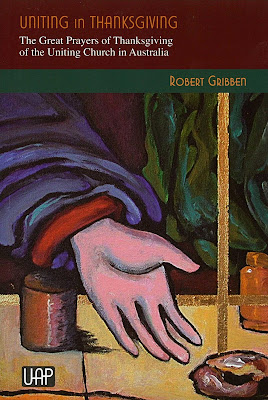Review of Robert Gribben's "Uniting in Thanksgiving"

This book is an extended commentary on the Eucharistic Prayers in use in the Uniting Church. Professor Gribben is admirably equipped for this task having been closely involved in the authorship of the prayers themselves as a member of the team that produced Uniting in Worship. I am a great admirer of the Uniting Church's liturgy and would that my own church would take as much care over its worship, or at least make some services available for those of us who want to do more than mimic Hillsong, recreate a camp meeting atmosphere, or make it up as we go along.
The Uniting Church has Prof. Gribben to thank for such admirable phrases in the Thanksgiving for Creation as, "In time beyond our dreaming you brought forth light out of darkness" and "We bless you for this wide, red land, for its rugged beauty, its changing seasons," words which evoke the Uniting Church's commitment to be an authentically Australian church. The expression in the Narrative of Institution, "Do this for the remembrance of me" rather than the expected "in remembrance of me" is something quite unique. It is a noble attempt to capture the meaning of anamnesis, which is so much more than just a reflection on a past event, but more a lived experience of participation. If the wording is at first a little disarming, this may lead to deeper reflection on their meaning which can only be a good thing.
The book is divided into three sections. First the "Genealogy" of the Great Prayer of Thanksgiving is given, tracing its historic precedents and giving an idea of its general structure and "theo-logic." Part Two, the lengthiest section of the book, is an extended commentary on each section of the Prayer, and a final third part is a practical commentary on its use. So the reader moves neatly from provenance, to meaning, to rubrics.
The book is a delight to read. Prof. Gribben writes in fine, engaging style. He is an internationally known liturgist and ecumenist who knows his material well. In addition to a deep familiarity with the Christian Church's wider liturgical and sacramental theology, being nurtured in the Wesleyan tradition, his appreciation for and knowledge of Methodism is clear throughout. The commentary is sprinkled with judicious anecdotes that keep the reader engaged and often shine a light on the theological meaning being considered.
This book certainly deserves to be read by members of the Uniting Church but anyone with an interest in Christian worship will benefit from it. One would hope that it would be used as a text in the training of Ministers of the Word and others responsible for leading worship in the Uniting Church. The provision of such a theologically well grounded liturgy needs to be accompanied by careful instruction regarding its use and this book meets that need admirably. It would be a pity if it were not widely read and used.
A word must also be said for the editors of Uniting Academic Press for the attractive design of the book, the first release from this new publisher. The glossy card insert which reproduces the Prayer itself is a useful tool for use in worship and makes a helpful bookmark, though sadly it has some typographical errors.
You can order the book from Mosaic Resources.

![Reblog this post [with Zemanta]](http://img.zemanta.com/reblog_e.png?x-id=44511f18-f946-4cae-a08e-a24c8dff860e)

![Reblog this post [with Zemanta]](http://img.zemanta.com/reblog_e.png?x-id=a3c357ff-823c-4d72-8c72-70f88ed8d345)

